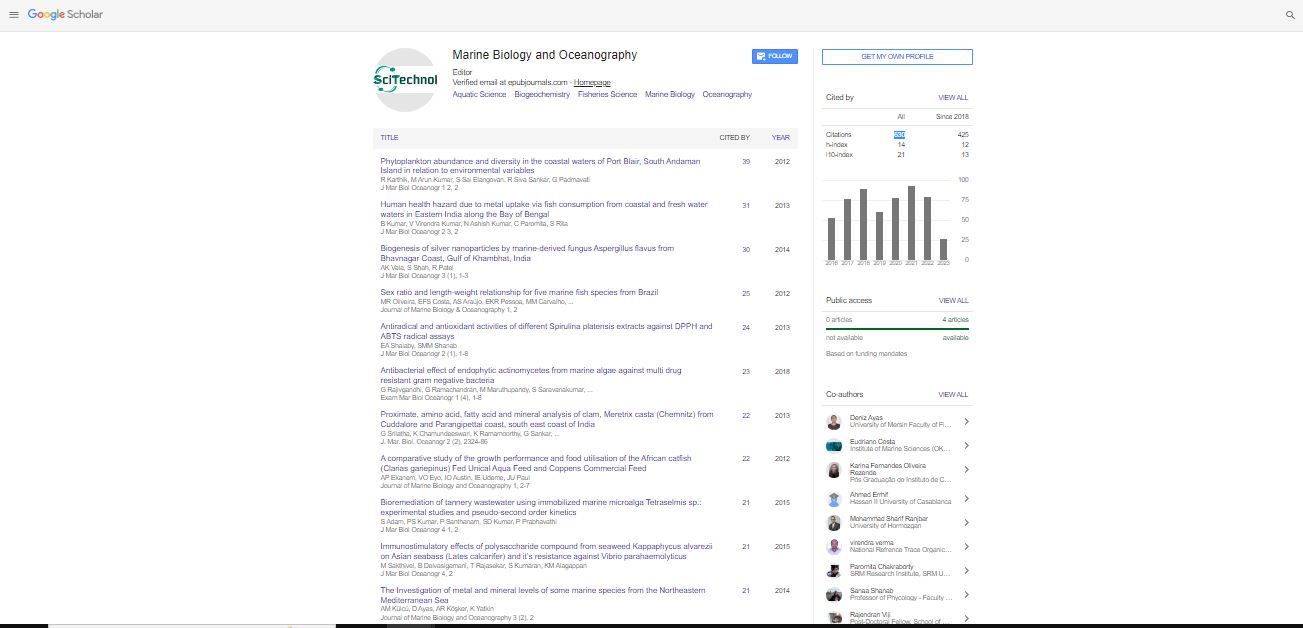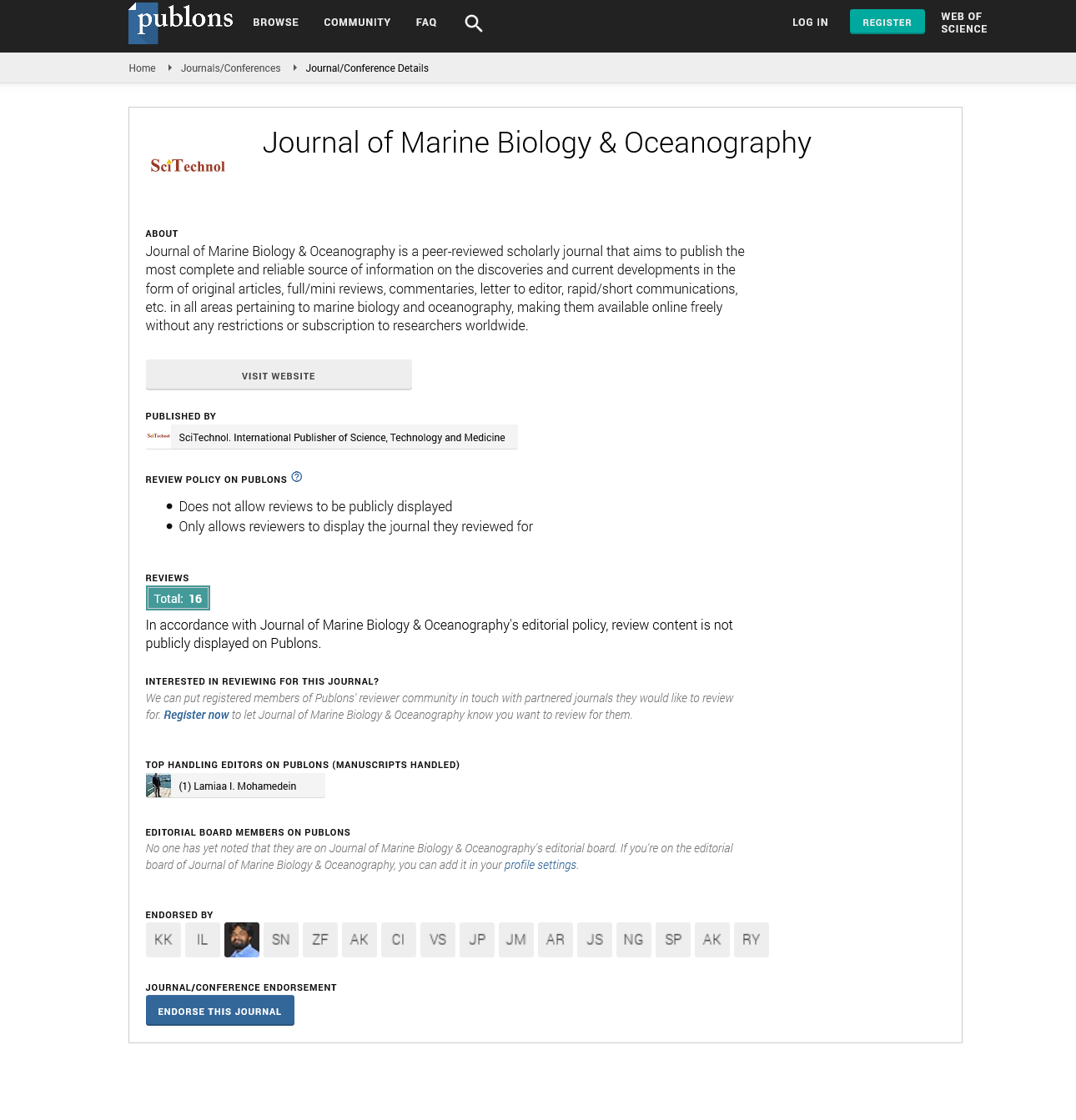Perspective, J Mar Biol Oceanogr Vol: 11 Issue: 4
Organizations in the Planning, And Management of the Marine Area
Katie Wan*
National Marine Data and Information Service, Tianjin, 300171, China
*Corresponding author: Katie Wan
National Marine Data and Information Service, Tianjin, 300171, China
Email: Katie@gmail.com
Received date: 16 March, 2022, Manuscript No. JMBO-22-62317;
Editor assigned date: 18 March, 2022, Pre QC No. JMBO-22-62317 (PQ);
Reviewed date: 29 March, 2022, QC No JMBO-22-62317;
Revised date: 08 April, 2022, Manuscript No. JMBO-22-62317 (R);
Published date: 18 April, 2022, DOI:10.4172/2324-8661.1000238
Citation: Wan K (2022) Organizations in the Planning, And Management of the Marine Area. J Mar Biol Oceanogr 11: 4.
Keywords: Marine Area
Introduction
The Nicaraguan lakes represent an ideal mainland- islet-like setting to study the colonization patterns of both fish and their spongers. The dominant fish fauna are cichlids, particularly the Midas cichlid species complex Amphilophusspp. A well-studied model for recent sympatric speciatio. Then, we characterized the Midas cichlid macro parasite diversity in Nicaraguan lakes. We estimated patterns of sponger diversity across host populations. Morphological and molecular analyses were conducted, revealing a macro parasite fauna composed by 37 taxa, including Platyhelminthes, nematodes, copepods, brachyurans, hirudineans and oribatids. Three invasive species are reported for the first time. The Midas cichlid was infected by 22 sponger taxa, 18 participated with other cichlids. Eight taxa conformed the core sponger fauna of the Midas cichlid. The large lakes had advanced sponger diversity than the lower and insulated crater lakes, although sponger infracommunity diversity was lower. Environmental factors along with the discrimination distribution of intermediate hosts, the implicit resistance gained by their hosts after colonization of new lakes, competitive rejection among spongers, or the preface of fantastic fish, may determine the observed pattern of sponger miscellaneous distribution. Our study provides a ground to explore the evolutionary history of both, hosts and spongers within the environment of speciation and diversification processes. The implicit nutritive value of duckweed Lemma minor (Lemnaceae) was estimated for common complaint Cyprinids carpi shindig. Fish were fed diets containing five canted situations of duckweed 0 (LM0, control), 5 (LM5), 10 (LM10), 15 (LM15) and 20 (LM20). The final weight and specific growth rate were significantly advanced in LM15 and LM20 diets fed fish compared to others. Feed conversion rate was minimal in fish fed diet LM20. Amylase exertion was significantly advanced in LM0 treatment. Total protease, trypsin and chymotrypsin conditioning showed direct connections with the increased position of duckweed in the diet. Protein and essential amino acids contents were significantly advanced in complaint fed diets LM15 and LM20 compared to others. Lipid content was significantly advanced in fish fed duckweed-grounded diets compared to control. A direct relationship was plant between the addition position of duckweed in the diet and n-3 long- chain polyunsaturated adipose acid (LC-PUFA) content of complaint. The monounsaturated adipose acids and n-6 PUFA contents reduced significantly in fish fed duckweed.
fads2d6, elovl2, elovl5 and Fas were advanced in complaint fed diets LM10, LM15 and LM20 compared to control fish. The addition of L. minor in diet enhanced the nutritive value of complaint by adding protein, lipid, amino acids and n-3 PUFA contents. Over the last half of the 20th century, the western Antarctic Peninsula has been one of the most fleetly warming regions on Earth, leading to substantial reductions in indigenous ocean ice content. These changes are modulated by atmospheric forcing, including the Amundsen Sea Low (ASL) pressure system. We employed a new 25-time (1993–2017) time series to model the goods of environmental variability on naiads of a cornerstone species, the Antarctic Silverfish (Pleuragramma Antarctica). Antarctic Silverfish use ocean ice as spawning niche and are important prey for penguins and other bloodsuckers. We show that warmer ocean face temperature and dropped ocean ice are associated with reduced larval cornucopia. Variability in the ASL modulates both ocean face temperature and ocean ice; a strong ASL is associated with reduced naiads. These findings support narrow ocean ice and temperature forbearance for adult and larval fish. Farther indigenous warming prognosticated to do during the 21st century could displace populations of Antarctic Silverfish, altering this pelagic ecosystem. The mechanisms of oceanic beast migration remain enigmatic. Adult Japanese eels start their long- distance oceanic migration from littoral areas to strain near the West Mariana Ridge.
We tracked acoustically tagged eels released in the Kuroshio Current (KC) area near Japan (five tableware-phase eels, three of which had bloodied syncope bladders) and a tropical/tropical (TS) area near/in the begetting area (two un heroic-phase and three tableware-phase eels). We anatomized their active swimming and transport by water currents. The strong inflow of the KC dominated the eels’ movements in the north, and TS area; their swimming told their movements. In the KC area, lesser distances were covered at night than during the day, because eels swam in shallower layers with strong currents at night. Three and one eel in the TS and KC area in the upper 400 m showed counterclockwise and clockwise movements around the time of solar capstone, independently. The meta-analysis showed that eels released at middle authorizations (20°–34°N) generally swam southward through currents, whereas those released at low authorizations (12°–13°N) generally swam northward through currents. Our study suggests the influence of the girding current and a implicit effect of solar cues on the movements of Japanese eels. Coastal territories are essential for ecological processes and give important ecosystem services.
Ocean Temperature on the Galapagos
The Galapagos archipelago has a wide diversity of ichthyofauna which preservation guarantees the functioning of the marine ecosystem. In this study, we used ecological and taxonomic indicators as well as multivariate analysis to identify spatiotemporal changes in fish community structure in littoral territories of San Cristobel Island in the southeastern Galapagos archipelago. We anatomized how the patterns of variability were related to the abiotic conditions (substrate, ocean temperature and depth) of each nich.
 Spanish
Spanish  Chinese
Chinese  Russian
Russian  German
German  French
French  Japanese
Japanese  Portuguese
Portuguese  Hindi
Hindi 
